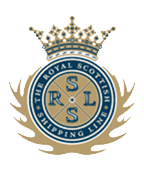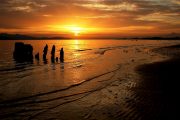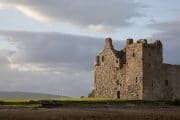Experience the famous and majestic Kyles of Bute, a firm favourite of those who regularly sail in the West of Scotland, sure to leave a lasting impression with its spectacular scenery as well as being steeped in history.
Then enjoy the romantic waters of Loch Fyne, Scotland’s longest sea loch, adorned with Castles and hill towers, and home to Loch Fyne oysters enjoyed in the world’s top restaurants around the globe.
 From our berth in Greenock, Spirit of Fortitude sets sail on a three-night cruise past Holy Loch, named for the sacred, yet sunken cargo from a ship carrying soil from the Holy Land destined for the foundations of Glasgow cathedral. Passing Dunoon then onto the Isle of Bute where we head north through the fabulous Kyles of Bute, past Tighnabruaich before heading into Loch Fyne, Scotland’s longest sea loch. We visit Portavadie; a place of great contrast. Portavadie is a must visit with its multi award winning spa experience. This is followed by a short trip across the loch to the wonderful fishing village of Tarbert where its ruined castle, once occupied by Robert the Bruce, stands guard over the harbour entrance.
From our berth in Greenock, Spirit of Fortitude sets sail on a three-night cruise past Holy Loch, named for the sacred, yet sunken cargo from a ship carrying soil from the Holy Land destined for the foundations of Glasgow cathedral. Passing Dunoon then onto the Isle of Bute where we head north through the fabulous Kyles of Bute, past Tighnabruaich before heading into Loch Fyne, Scotland’s longest sea loch. We visit Portavadie; a place of great contrast. Portavadie is a must visit with its multi award winning spa experience. This is followed by a short trip across the loch to the wonderful fishing village of Tarbert where its ruined castle, once occupied by Robert the Bruce, stands guard over the harbour entrance.
Arran is the largest of the Clyde islands and we visit the north west of the island at Lochranza, a lovely tranquil setting for a very popular distillery. Opened in 1995, the Isle of Arran Distillery boasts a welcoming Visitor Centre and a number of excellent whiskies. There is also the visitor attraction of Arran Aromatics famous for its luxury Scottish made toiletries.
Passing places, anchorages and ports
Greenock
From its humble beginnings as a fishing village in the 15th Century, Greenock and its access to the River Clyde made it an important location for servicing the busy city of Glasgow until the 1800s and then became the shipbuilding capital of the world. Set on steep slopes, it has magnificent views across the firth of Clyde to the mountains beyond.
Holy Loch
Historically home to the American Naval base, set in a fault line and named for its sunken soil cargo once destined for Glasgow Cathedral.
Isle of Bute- Rothesay
A quaint Victorian seaside resort, full of its original architecture, packed with character. It even boasts original Victorian toilets on the pier that are the only facilities in Scotland to be given their own visitor leaflets! Decorated in the most splendid tiles with opulent colour schemes, highlighting the no expense spared when it came to the Victorians. Along the esplanade lies the unique cast iron and glass, circular structure of the Discovery Centre and further along is Rothesay Castle – which was a favourite home of early Scottish kings and still sports dungeons that can be toured. The Island is home to the famous Mount Stuart which is considered Scotland’s most romantic wedding venue with its opulent architecture. Prince Charles is the Duke of Rothesay.
Kyles of Bute
This majestic secret hideaway at the north end of the Isle of Bute is an area of outstanding natural beauty, as well as a SSSI site. This narrow stretch of water separates Bute from Argyll. Ranging from a width of 2 miles right down just a few hundred yards at Rubha Ban there are many sheltered anchorages along the way where we are likely to stop so you can watch the local wildlife. A well-known spot, said to be the grave of Meckan, son of Magnus, king of Norway, who was killed in the battle fought at Crudail.
Tighnabruaich
On the shores of the Kyles of Bute, considered one of the prettiest villages in the area. Famous for its sailing and yachting, visited often by the much loved paddle steamer The Waverley, the world’s only remaining sea-going paddle steamer. Part of Argyll’s Secret Coast, with the sight of the rolling hills across the water it is easy to see why Tighnabruaich remains a favourite stopping point each year. Great for those Parry Handy fans!
Portavadie – Loch Fyne
Historically this was a small fishing village, transformed decades ago during the oil rush, now one of the UK’s most modern marina’s, this man made lagoon is perfect for a place to stop and enjoy the world class spa and leisure facilities.
Tarbert – Loch Fyne
The loch of the Vine or Loch Fyne is the longest of the sea lochs and joins the Sound of Jura through the stunning Crinan Canal. Home to the second largest sailing regatta in the U.K as well as host to the famous seafood festival, this very pretty little town has a way of capturing the heart with its pretty buildings and great atmosphere. Tarbert, situated on Loch Fyne has an internationally acclaimed heritage of oyster fishery, “Loch Fyne Oysters” which have graced the finest dining establishments around the world.
Arran- Lochranza
Arran is full of beautiful coastlines, rolling hills, woodlands and mountainous terrain. The most southerly Scottish Isle is 19 miles long by 10 miles wide but offers some stunning seascape vistas at every turn. Easily described as a miniature Scotland due to the variety of terrain, as you traverse the island you will feel that you are miles away from the hustle of everyday life. Packed full of things to see and do this is a very popular Isle with the Scot’s many of whom take their holidays on this wee Isle. A modern but popular distillery and Arrans own manufactured soaps and lotions with its visitor centre it has proved very popular, Taste of Arran ensures the quality of food is kept to a very high standard with plenty of artisans producing on this isle. Lochranza, perhaps the most attractive of all the Arran villages. Proudly possessing not one but two Castles, nestled on the banks of the Ranza, it is sheltered on three sides by hills and faces the dominating ruins of its castle as it sits on its shingle spur out into the loch. Thought to be the basis for the Tintin adventure “The Black Island”, the castle dates back as far as the 13th Century. Lochranza is home to a large population of red deer, and these can often be seen grazing on its golf course. The mountainous surroundings provide some of the most brutal and jagged scenery in the area which makes it an ideal location for Golden Eagles. Loch Ranza is the place to look for the seals that are often on view.
Millport
The only town on the island of Great Cumbrae and famous for having the UK’s smallest cathedral, the town grew in popularity during the Victorian era and much of the original architecture still exists. The town curves around the south coast on a hilly bay and you simply must look out for the crocodile rock that resides on the shore. The three isles Cumbrae, Arran and Bute only became part of Scotland in 1263 when Alexander the third defeated Norse King Haco at the famous battle of Largs.










Tour Reviews
There are no reviews yet.
Leave a Review